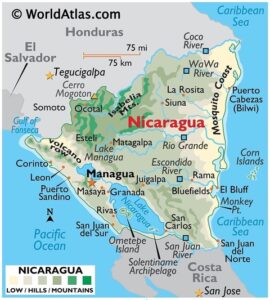A Hasty Site Plan, an Early Windfall, a Lesson in Real World Economics
Chapter Two of The Challenge of Charity
It was a crude sketch, pencil drawn on the inside cover of a book I was reading. I think it was Mark Twain’s A Tramp Abroad…
It represented our oceanfront lots. A grid of 36 lots in three rows. Twelve lots per row. We figured we could get $35,000 for the first row – the ones that sat directly on the beach. We priced the second row at $30,000, and the third at $25,000.
Thinking back on that now, and considering what those lots are worth today, it’s hard to fathom why we sold them so cheaply. And why we sold some of the best lots – the oceanfront lots – so early in the game.
The answer is that we knew practically nothing about selling this kind of real estate.
We’d each had some experience in real estate. I had even been a limited partner in similar Florida-based projects. But I didn’t run those projects. Nor was I included when it came to pricing the lots.
So, how did we arrive at those prices?
We didn’t look at “comps” – the prices of comparable properties – because there were none. In fact, in the late 1990s, there weren’t any beachfront housing developments within a hundred miles of ours on Nicaragua’s Pacific Coast.
A strategy we might have had, but didn’t, would have been to base our prices on similar lots in the States. US property was considerably cheaper than it became 30 years later, but beachfront lots in Florida or California typically sold for $500,000 to more than $5 million.
I believe what we did – and in retrospect, it does seem naïve – was to price those 36 parcels so that the total would equal the $1 million we had by then invested in the property. (A purchase price of $800,000 plus about $200,000 in development costs.)
How did that go?
From one perspective it went extremely well. We sold all 36 lots in 48 hours, sight unseen!
“Holy mackerel!” we thought. “We’ve struck it rich!”
Our next thought, of course, was, “Gee whizz. We probably could have priced them at twice or three times those amounts and still sold out.”
This was just one of the many mistakes we made in developing that rustic and desolate cow ranch into a five-star residential resort community.
* We never had the property surveyed.
* We didn’t test the soil.
* We hadn’t looked for natural springs or plumbed the aquifer for water.
* We hadn’t figured out how to bring electricity from the road to the building sites (a stretch of about two miles).
* We knew nothing about building regulations in Nicaragua.
* We didn’t even know a single builder.
Hindsight, as they say, is 20/20. And although I do believe we could have sold the 36 lots at a higher average price, what we did by selling them so cheaply was generate the immediate cash flow that was critical to getting our fledgling business off the ground.
And there were two things that, even in our ignorance, we did right:
* We paid a very good price for the property we bought.
* We wasted no time in trying to sell the lots to our International Living subscribers.
From Cow Paths to Graded Roads
In the first year after purchasing the property, we built a lot of infrastructure.
We built a two-mile long dirt road stretching from the main entrance on the dirt road that went from Rivas City to the ranch. We brought in electric from outside the ranch along the main road, from the entrance down to the beach. We dug two wells to provide water to the 36 lots we had just – to our surprise and delight – managed to sell.
As I said, all that took about a year to complete. It also took every cent of the $200,000 we had put aside for infrastructure.
Next on the agenda was an onsite sales office. Our idea for that was very basic: a 1,200-square-foot structure with an open floor plan, two small bathrooms, and a palapas-covered roof. We located it on a tree-covered bluff overlooking Playa Rosada, the stunningly beautiful beach at the heart of our first phase of development.
This, we finished in about six months.
Over the next 18 months, we added a three-room hotel with a kitchen and outdoor dining room, and a Tiki-style bar beside a small pool looking on to Playa Santana.
That construction was financed by selling additional lots along a cove on the other side of the bluff. These lots were also sold sight unseen to our subscribers.
Our initial capital investment – among the four partners – was less than half a million dollars. Way too small for a project of this size. But because we had a ready market that we could reach for free (by email advertising), I don’t think we ever tapped into that original capital pool.
A Home, a Problem, and a Disturbing Solution
Encouraged by our progress and stimulated by our growing infatuation with the beauty and culture of this heretofore undiscovered coast of Nicaragua, several of the partners and I decided to build second homes in Rancho Santana for our own families.
We spent a day with Antonio, the local we had bought the property from (and now our partner), riding horses and walking ridges with fantastic views. I found a great spot about a quarter-mile from the first section we had developed. The lots we had carved out there were small – just a quarter-acre each. I claimed two of them.
Ours was one of the first houses built in Rancho Santana. Compared to what came later, it was modest in size, but felt spacious. At 1,500 square feet, it consisted of three small bedrooms, a kitchen, and a large open-air living room with a spectacular view of the northern shoreline and the hills beyond.
The house was completed in less than year. Soon after it was finished, K and I spent a week getting the feel of it.
The open-air living room, which we’d thought would be a brilliant way to take advantage of the views, turned out to be a bad idea. In the heat of the day, it was too hot. During the rainy season, it was cooler, but the rain often came in almost horizontally and soaked everything.
If that wasn’t enough, birds and bugs and bats ensconced themselves in the beams that held up the roof, from which they would occasionally drop down and sometimes settle on the dining room table while we were eating.
In the windy season, breezes blew continually through the open areas, leaving a layer of dust everywhere.
“It’s normal, my friend,” Antonio said with a smile when I complained. “If you want to live outdoors, you must submit yourself to Mother Nature.”
For the rest of that first visit, we tried to be outdoorsy. But the following year, we enclosed the dining and living “rooms.”
Meanwhile, it became obvious that it was going to be impossible to keep the place as neat and tidy as we were accustomed to in the US.
Antonio recommended that we get a full-time housekeeper.
In the US, a housekeeper is something only the wealthy have. We were financially comfortable, but we would never have considered having a full-time housekeeper in the States. When I asked Antonio how much it would cost, I was shocked at his answer.
“I pay $80 a month,” he said. “But for you, as a Gringo, maybe $100.”
But this created another problem that was just as disturbing. I couldn’t conceive of paying a full-time worker only $100 a month. It felt financially abusive – like pure, old-fashioned Colonial-era exploitation.
“Honestly,” I said to Antonio, “I wouldn’t feel at all comfortable with $100 a month. How about $400?”
He put his arm around my shoulders and gave me a little hug. “Sit down,” he said.
I sat.
“Mark, I know you. You are not a bad or a stupid person.”
“Thanks a lot,” I thought.
“You feel that way because you have grown up in America. You have lived all your life in a big, rich economy. But Nicaragua is different. We are a poor country. We want to grow richer, but we know that if it comes, it will come slowly.”
Antonio was not simply a local property owner and an entrepreneur. He also held two degrees, one in agronomy and another in business administration from a US university. On top of that, he had spent several years working in the US.
He understood the employment market in the US and in Nicaragua, and he’d had a few courses in economics. Which made him a good deal more knowledgeable in these things than I was.
More importantly, he had a genuine concern for the welfare of Nicaragua and its people.
My First Lesson in Real Third-World Economics
Before we started building Rancho Santana, there were very few employment opportunities in this part of the country. It was a subsistence economy. Most people lived in the crudest shacks, with dirt floors and latrines. They literally lived off the land. Rancho Santana greatly expanded the demand for labor.
There had been something of an existing job market. The larger farmers employed some people, and there were a few small businesses that employed others. So, there was an established standard of how much one could expect to earn as a laborer. And that was the government-mandated minimum wage of about $80 a month. Managers and skilled laborers earned about twice that much. And doctors and lawyers earned, on average, about $400 a month.
This was Antonio’s argument to me:
“You are an investor in our country. And your investment will help us grow rich. But you must be thoughtful about the ideas you get about what you pay people. If you pay your one housekeeper four times the going rate, you will cause trouble not only for other homeowners, but for all the local people that would like jobs.
“Keep in mind that we are building a dream here with Rancho Santana – a project that could one day be employing hundreds or even thousands of people, people who right now have no employment.”
Embarrassing Afterthoughts
The more I thought about Antonio’s argument, the more embarrassed I felt. Without giving the matter a moment’s thought, I had decided to pay my first Nicaraguan employee four to five times the going rate. Even at that rate, I felt like I was taking advantage, because $400 a month was still less than 25% of what an unskilled laborer would make in the States.
But I had never considered the potentially larger impact of what I was considering doing.
It would have made me happy and would have thrilled the housekeeper I would hire. But it would have ignored – at a considerable cost – the negative effect my singular decision would have on the social and economic reality of the hundreds of poor people living nearby.
This wasn’t going to be the last time I made this mistake. As I’ll explain in later chapters, I made it again and again in different circumstances and in different ways.
I was eventually able to understand what I was doing. I realized that, like most of my generation, I’d come to accept an ethos of fairness and justice and charity that felt inarguably true… so long as I didn’t think too much about it.
Lessons Learned
* When it comes to developing property, the cost of the land is going to be a small part of the overall cost of the development. In the States, it may be 30% to 40%. In areas without a developed central infrastructure, it may be less than 10%.
* Culture is everything. When making business decisions in a foreign country, recognize that the effects of your actions are likely to have different ramifications than the same decisions made at home.
Inertia
From The 7 Natural Laws of Wealth Acquisition
Let me tell you a story…
During the time I was publishing Early to Rise (from 2000 to 2010), my partners and I held annual conferences for our subscribers. They usually included events where we (the speakers) would sign books of ours that some of the attendees had bought in the pop-up gift shops.
I always enjoyed doing this because it gave me an opportunity to meet dozens of the attendees personally and have, however briefly, chats about who they were, why they had come, and what benefits they hoped to reap from the conference.
Roughly half of those who attended had not yet set upon whatever journey they were planning. They came hoping for some insight or introduction or advice that would get them on their way. And almost invariably, when I asked them if they had found the spark they were looking for, they said they had. And judging from their energy and excitement, I believed them.
A good number of those people returned in subsequent years. And if I asked them what progress they had made since the last conference, I was disappointed to discover that many had made no progress at all.
When I asked them why they were still stuck at Step One, they had all sorts of reasonable explanations ranging from unexpected financial problems to unexpected marital issues.
And the same thing happened again and again, year after year.
What was going on?
It wasn’t laziness.
Most of these people had challenging professional jobs that required working 45+ hours a week. Some had second jobs to earn extra income. Many spent portions of their leisure time reading and doing research for side projects they were interested in. These were not sluggards. Something else was afoot.
Nor was it a lack of connections and/or resources.
Among the people that kept coming back without having made any progress, there were plenty who came from affluent families, lived in upscale communities, and had all the money they needed to get working immediately on their goals. In fact, there seemed to be an inverse relationship between the resources people had and their ability to move forward.
Nor was it the “fear of failure.”
A common explanation for this sort of procrastination is fear of failure, but that never rang true to me. I had started dozens of businesses. I knew that not all of them would be successful, but that didn’t stop me. And yet, I had often spent months planning or talking about starting some new venture that never got off the ground.
So, what was it? What could I learn from my own bouts with procrastination that could explain the inability to move forward on specific goals.
Since I have kept detailed journals of my daily thoughts and actions for more than 30 years, I spent some time looking through the entries I’d made, looking for a common thread.
It didn’t take long to find it. My problem hadn’t been laziness or a lack of resources or a fear of failure. My problem was that that I did not know how to start.
Think about your own dreams. Think about the goals you’ve set for yourself over the years but failed to achieve.
Perhaps you’ve always wanted to write a book. Or learn a foreign language. Or have an exotic adventure. Or start a successful business. And yet, as you are reading this today, you realize that you have not done it.
My proposition to you is that you haven’t accomplished those goals because you knew in some core part of your mind that what has held you back is the realization that you simply didn’t know how to take Step #1.
Let me see if I can convince you of this proposition with a very brief thought experiment.
Imagine this…
You get a job in the accounting department of a successful company that sells widgets. You work like a demon six days a week and get one promotion after another until, after only three years, you are promoted to CFO, and the next year to COO. At this point, you know everything about how the business works. You know how to manufacture the widgets. You know how to sell them and who the buyers are. But there is something else you know. You know of a supplier that can get you the materials for half of what you are currently paying.
You’ve told your boss about this opportunity, but he’s said he’s not interested. So, you decide to open your own widget shop. You can hire a few key employees you already know from the industry. And you know just which customers would be happy to buy widgets from you.
Question: Would you be afraid to start that business? Of course not!
On the contrary, you’d probably move as fast as you could, fearing that someone else might do it first!
This illustrates what I believe is the reason most people (like 80%) fail to accomplish their wealth building goals. In business and other forms of human endeavor, we call it procrastination. And it is caused by the very accurate (but often only subconsciously understood) fact that they lack a simple road map to follow.
In science, the tendency of an object at rest to remain at rest is referred to as inertia – which, you may remember from an Introduction to Physics class, is Newton’s First Law of Motion.
And inertia is one of our laws of wealth accumulation.
The Mistake Most People Make re Inertia

Look at this tennis ball.
It’s just sitting on the ground, not moving. It exerts no energy, and it appears that no energy is being applied against it. Thus, from a physics perspective, we would describe it as being “at rest.” The same is true of a person who is sitting still on a bench.
But, in fact, both the tennis ball and the person on the bench are subject to multiple forces of energy that are negating their movement.
Inertia explains why 95% of those who embark on learning languages or playing a musical instrument never get past the introductory material. It explains why almost all New Year’s Resolutions are abandoned before the end of February. It explains why many new businesses never get off the ground – and why those conference goers came back year after year without making any progress on the goals they had enthusiastically set a year earlier.
Defeating inertia is 80% about “Getting Ready.”
If you’ve tried but failed to increase your income and/or become wealthier in the past, the advice I’m about to give you may prove more valuable than any strategies you’ve tried.
The commonsense approach to getting started on any goal is to do something – read a book or take a class or attend a lecture – that inspires you. And that is why there is an entire industry that specializes in this area of human psychology.
But if you’ve read the books or taken the classes or attended the lectures, you probably also know what follows. You’re busy with the demands of your current life – and so you promise yourself that you will start the following week or the following month or after your next vacation or after your upcoming wedding or after you finish remodeling the bathroom. And then, suddenly, a year has passed, and you’ve done nothing.
Overcoming Inertia as an Entrepreneur
The first section of Ready, Fire, Aim, my bestselling book about entrepreneurship, provides a step-by-step guide to moving a business from revenues of zero to one million dollars. What I do in that section is provide would-be entrepreneurs with what could be described as an easy-to-understand guide to overcoming entrepreneurial inertia.
It boils down to discovering what I call the Optimal Selling Strategy (OSS). And it’s a simple matter of answering the following five questions:
1. Who are the people most likely to buy the sort of product or service I intend to sell?
2. Where (using what advertising media) am I going to find the largest percentage of them?
3. What sort of offer will be most appealing to them?
4. What kind of pitch will they most strongly respond to?
5. What can I do with my product that will make it 90% the same as the best of my competition, but 10% better?
You will probably see these questions as rudimentary. And they are. Which is exactly the point! But finding the OSS is how you gain the confidence to take action.
Overcoming Inertia to Get Rich as an Investor
I’ve been in the investing business as a publisher and as an author for more than 40 years. And one of the things I’ve learned is that investing the way most people do it is a formula for failure.
Something like 80% of professional brokers and money managers fail to beat stock market averages over 10 years or more. Even on a yearly basis, the majority fail at this very minimum objective.
What’s worse, individual investors do three times worse than the pros. Over a hundred years, for example, the US stock market has gained about 10%. Yet individual investors, as a group, have made less than 3%.
The reason is similar to the reason most would-be entrepreneurs fail.
They may read financial newspapers or newsletters. They may watch the financial news. But they don’t have the confidence to take the kind of decisive action necessary to succeed long-term because they don’t know the answers to basic questions about how the stock market works and about the individual stocks they are considering buying.
Questions like these:
* What makes the market go up and down?
* What makes certain stocks go up and down independent of what the market does?
* What investment factors are responsible for producing market-beating returns?
* For the stock you’re looking at, which part of the business cycle is its industry in?
* How does this business make money, and what are its prospects for growth in the future?
* Does the company behind this stock reward shareholders?
* Does the company have an enduring competitive advantage?
* Does the company produce a product it can sell 50 years from now, or does it constantly have to reinvest in remaking or changing its product?
* What is the company’s position in its industry?
* What are the risks to the company that could drive its stock price lower?
When I was new to investing, I could not answer those questions myself. So, what I did was assemble three of the best investment analysts I had access to.
That led to the creation of the original Legacy Portfolio, which, from 2012 to 2024, produced a return of 10.4% per year on average. Moreover, the level of risk inherent in the approach we developed for that portfolio was much lower than that of other portfolios that had achieved similar ROIs.
When my personal broker and Sean teamed up to take over managing my Legacy Portfolio, they contributed their knowledge of various sectors of the market to make the portfolio not only safer, but able to invest and trade in categories that I had been afraid to venture into.
With each innovation, I questioned them about anything I didn’t understand. And their answers were always rational and clear. That eliminated the doubts I had. And with those doubts gone, so was the inertia I felt about moving forward.
What I believe we have now in the Legacy Portfolio is the investment equivalent of what I built for entrepreneurs in Ready, Fire, Aim. It is a strategy of stock selection and management that operates out of accumulated knowledge and the confidence that increases every year as the portfolio continues to outperform the markets.



